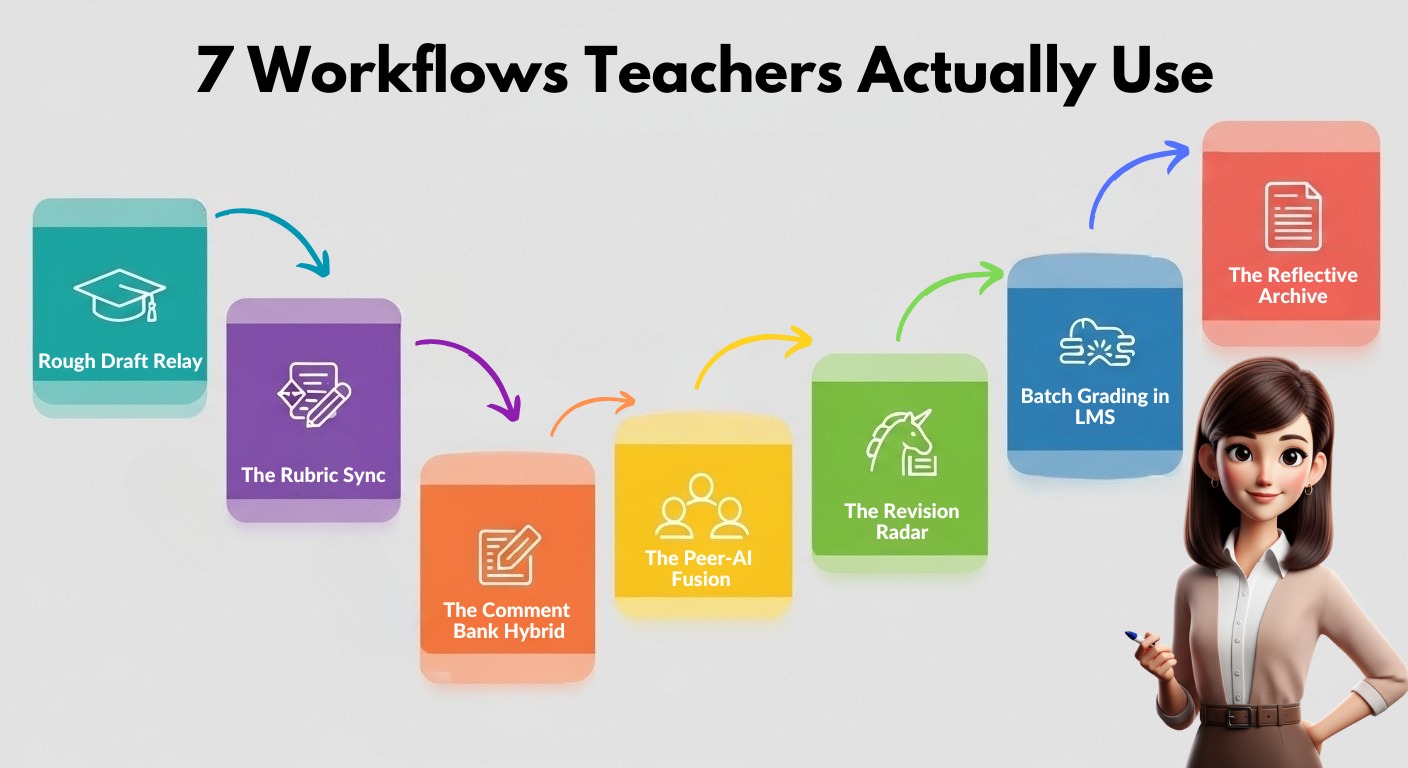The Timeless Struggle of Essay Grading
It’s no secret that grading essays has always been the marathon of teaching. Each paper holds promise and potential, but also hours of analysis, annotation, and reflection. “Grading isn’t just correction—it’s craftsmanship,” says Ms. Lopez, an 8th-grade ELA teacher in California. “Every essay is a conversation, and I want to respond to each voice.”
Yet even the most dedicated educators face the same bottleneck: time. Between lesson planning, parent conferences, and state assessments, finding hours to grade thoroughly can feel impossible.
That’s where AI essay grading enters—not as a shortcut, but as a strategic ally. Across U.S. classrooms, teachers are quietly reimagining the workflow: blending the best of human insight with the speed and structure of technology. And the results? Essays graded faster, feedback made clearer, students more engaged.
So what does that look like in practice? Below are seven proven workflows teachers actually use, built from classrooms, pilot programs, and the lived realities of educators who dared to ask: Can I grade my essay AI-style—without losing the human touch?

1. Workflow One: The “Rough Draft Relay” (Pre-Feedback Power)
In this approach, teachers use a free essay grader before the grading even begins. Students submit their rough drafts through an AI essay grader free tool—sometimes embedded directly in Google Docs or Google Classroom.
The goal? Early feedback, not final judgment.
Mr. Patel, a high school English teacher in Arizona, uses this workflow weekly. “When students get preliminary comments from a free AI essay grader,” he explains, “they see the patterns—missing transitions, vague claims—before I ever pick up my pen.”
Here’s how it works step-by-step:
- Students upload essays to an AI platform (like Essay Eye, Google Docs add-ons, or other free essay grader tools).
- The AI provides a score prediction and a few key improvement areas—organization, evidence, or clarity.
- Students revise, reflect, and resubmit for teacher review.
This essay grading workflow turns machines into mentors. It allows educators to focus on nuance—voice, tone, insight—while AI handles mechanics and structure.
Metaphor check: The AI acts as the chisel; the teacher remains the sculptor.
2. Workflow Two: “The Rubric Sync” (Where Rubrics Meet Reality)
Rubrics are teaching’s unsung heroes. They bring order to chaos, logic to subjectivity. But translating those rubrics into consistent grades—especially across 100+ essays—is exhausting.
That’s why teachers are increasingly using AI essay grading aligned to rubric categories. Platforms like Essay Eye and similar grade my essay AI tools allow teachers to input their exact rubric language (say, “Claim and Evidence,” “Organization,” “Conventions”) so that AI scores align with Common Core or district standards.
The magic happens when AI transforms rubric criteria into data. Essays are sorted by score bands, color-coded, and searchable. A teacher can instantly pull up all essays that scored a “2” in analysis or a “3” in conventions.
Imagine Ms. Lopez’s midterm grading cycle. In one weekend, she processes 92 essays—each tagged, scored, and sorted automatically. She still reads every essay, but now with a map. “It’s not about replacing judgment,” she says. “It’s about reclaiming my weekend.”
This workflow demonstrates how AI essay grader free tools can enhance fairness. If grading once felt like a guessing game, it now feels like a calibrated compass.
3. Workflow Three: “The Comment Bank Hybrid” (Saving Time, Saving Voice)
Feedback fatigue is real. Re-typing “expand your evidence” fifty times a night drains both clarity and compassion.
The Comment Bank Hybrid workflow blends automation with authenticity. Teachers store common feedback phrases—either in their LMS or within an AI essay grader interface—and the AI suggests the right comment in real time.
For example:
- “Consider adding a transition between your examples.”
- “Strong thesis, but evidence needs more elaboration.”
- “Excellent conclusion—reflective and complete.”
When the teacher clicks a comment, the AI can personalize it: “Great job, Julia! Your evidence is strong, but make sure to connect it back to your thesis.”
This “hybrid” model keeps grading human yet efficient. It’s how Essay Eye structures its AI essay grading workflow—teachers remain in control, but the system anticipates their next move.
Analogy: Think of it like jazz—AI sets the rhythm, teachers improvise the melody.

4. Workflow Four: “The Peer-AI Fusion” (Students as Co-Graders)
One of the most transformative shifts in essay evaluation is giving students agency. In this model, students use a grade my essay free tool for peer review before the final submission.
Picture a 10th-grade classroom: laptops open, students reviewing each other’s essays through an AI essay grader free interface. The AI flags grammar, structure, and clarity issues—while peers add comments about argument strength and originality.
This dual feedback loop fosters both skill and empathy. Students learn the language of rubrics and constructive critique.
As Mr. Patel notes, “When they start saying things like ‘your reasoning needs more textual support,’ you know the feedback culture is working.”
Here’s what makes this workflow special:
- It multiplies feedback without multiplying teacher effort.
- It encourages self-reflection through peer models.
- It integrates essay grading literacy into classroom culture.
And when students improve their own writing, teachers ultimately spend less time correcting and more time celebrating growth.
5. Workflow Five: “The Revision Radar” (Before the Grade Comes Growth)
What if the grade wasn’t the end, but the beginning?
In the Revision Radar workflow, the teacher uses AI essay grading not to finalize grades but to fuel reflection. After an essay is scored, students receive AI-generated summaries highlighting specific areas for revision.
For instance, the AI might say:
“Your essay demonstrates a strong central argument but needs clearer topic sentences in paragraphs 2 and 4.”
Students then use that insight to guide their next revision.
Across districts in California and Texas, this approach has reshaped grading cycles. Instead of a one-way verdict, grading becomes a dialogue. AI accelerates that loop, returning results in seconds so learning continues while engagement is high.
Ms. Lopez reflects, “When feedback arrives fast, revision becomes powerful. It’s like catching the wave while it’s still moving.”
In this sense, AI essay grader tools don’t replace feedback—they amplify it.

6. Workflow Six: “Batch Grading in LMS” (One Dashboard to Rule Them All)
At scale, even the best feedback workflow collapses under sheer volume. That’s why many districts have turned to integrated LMS-based AI essay grading systems.
Imagine logging into Google Classroom or Canvas and seeing every essay automatically pre-scored by a free essay grader—with comment drafts already queued for teacher approval.
The teacher reviews, adjusts, and releases feedback in batches.
This is the batch workflow, and it’s changing grading logistics across the board. It eliminates file-shuffling, spreadsheet sorting, and manual score entry.
In classrooms across the Midwest, where internet bandwidth can be inconsistent, teachers use lightweight browser extensions that sync with their LMS offline. Once online, data uploads instantly—no extra steps, no lost time.
Rhetorical question: What would grading look like if it weren’t so rushed? The batch model answers it clearly: streamlined, centralized, stress-free.
7. Workflow Seven: “The Reflective Archive” (Data Meets Development)
The final workflow is about perspective. Once essays are graded—whether by human, AI essay grader, or both—the process often ends. But what if teachers used that data to grow?
In the Reflective Archive, teachers export AI-generated analytics that reveal trends:
- Average essay grade by skill category.
- Frequency of specific rubric issues.
- Progress over time per student or class.
When teachers track these metrics, they gain insight into their own instruction. A sudden dip in “evidence integration,” for example, may signal a gap in classroom modeling.
Platforms like Essay Eye visualize this growth with graphs and filters, allowing educators to plan targeted mini-lessons.
Mr. Patel puts it simply: “It’s not just grading essays—it’s grading my teaching.”
Philosophical note: Data doesn’t replace intuition; it deepens it. When reflection becomes routine, professional growth accelerates as surely as student learning.

9. Human Truths Behind the Tech
Time is the rarest resource a teacher has. Every workflow above honors that truth.
Some may still question AI’s role: Does it dehumanize writing? Does it dull the art of teaching? Understandably so. But look closer—these workflows aren’t about surrendering judgment; they’re about reclaiming it.
AI essay graders don’t erase the teacher’s touch; they preserve it by clearing away the clutter.
Think of grading as gardening: AI weeds the routine so teachers can cultivate the roses. The human eye still matters. The teacher’s empathy, intuition, and humor—the little smiley face next to a clever sentence—still matter.
What changes is scale. Reach. Balance.
10. Why Essay Eye Stands Out
Among countless AI essay grader free platforms, Essay Eye distinguishes itself by understanding educators first. It’s designed not for data scientists, but for teachers who live inside the rhythm of the school year.
- Google Classroom Integration: Essays appear instantly in one dashboard.
- Rubric Mapping: Matches your school or district’s criteria word-for-word.
- Batch Mode: Grade, review, and export results at once.
- Feedback Builder: Combines your comment bank with AI suggestions.
And most importantly, Essay Eye maintains FERPA compliance—no student data leaves secure servers.
In a world overflowing with “AI everything,” Essay Eye remains teacher-built and classroom-tested. It’s the difference between a tool and a teaching partner.
11. The Subtle Shift: From Grading to Guiding
Each of these seven workflows represents a quiet revolution.
They don’t replace the teacher—they restore the teacher’s focus on what matters most: growth, reflection, creativity.
Grading has always been a mirror of learning, not merely its measure. And when technology becomes the mirror’s frame, not its reflection, both clarity and compassion increase.
So whether it’s a grade my essay AI tool helping a freshman revise their first literary analysis or an AI essay grader free platform streamlining district assessments, the message is the same: the future of essay grading is faster, fairer, and more human.
And maybe—just maybe—weekends can belong to teachers again.

